Earning money as a content creator looks different depending on your niche and skills, but some of the most popular ways to earn an income are monetizing your content and coming up with unique digital product ideas.
You can sell and distribute digital products many times over, and you’ve probably bought some digital products yourself! Digital product ideas span from online courses and fitness apps to downloadable resources and even art.
With so many different options for profitable digital products to sell, you might be wondering which ones are the best to invest your time and money in.
But before we share our list, let’s get clear on what digital products are.
What is a digital product?
A digital product is any virtual or intangible item that you can buy and sell on the internet.
As long as you’re selling or buying something that doesn’t have a physical form you can hold and feel, it passes for a digital product — which means the number of digital product ideas to sell online is virtually unlimited. Some of the most common examples you’ve probably encountered include:
- eBooks: Digital books spanning fiction stories to nonfiction guides and educational materials
- Webinars and courses: Online educational programs, workshops, and tutorials delivered through video, interactive content, and downloadable resources
- Downloadable content: Templates (for resumes, social media, business plans, and more), printables, digital planners, and design assets (such as fonts and icons)
- Music and audio: Digital albums, singles, sound effects, podcasts (premium or ad-free versions), and audiobooks
- Digital art: NFTs, digital illustrations, graphic designs, photography presets, and custom digital portraits
- Paid subscriptions: Access to exclusive content, premium features, curated newsletters, or ongoing support for a digital tool
- Community memberships: Access to private forums, Discord servers, or Facebook groups where members can connect
- Digital software: Software as a service (SaaS) applications, mobile apps, plugins, themes for websites, and desktop programs
- Virtual services: Remote consultations, coaching, or other services when face-to-face instruction is needed
This is far from an exhaustive list. If you can think of a product that has no tangible form and can be sold online, congratulations! You’ve come up with an idea for a digital product.
Benefits of selling digital products
You may be wondering whether there’s room for you to carve out a piece of this industry, what it takes to create your own digital products, and whether it’s really worth it. The answer is a resounding yes.
The digital product landscape is booming, fueled by the rise of the creator economy and influencer culture. No matter which digital product examples speak to you, you’ll find that many can be advantageous for several reasons:
Strong market demand
Demand for digital products has skyrocketed, largely thanks to the booming expansion of online learning. Today, the e-learning market is projected to grow 20.5% by 2030, reaching over $250 billion in market value.
Several factors are fueling this growth, including:
- A shift toward digital education: Schools and learning institutions are leaning into digital tools and platforms, transforming education.
- Accessibility and convenience: Online learning offers flexibility, allowing students to learn anytime and from anywhere in the world.
- Expansion of e-learning platforms: Online courses, eBooks, and educational apps allow creators to serve different educational needs and preferences, and the global online learning platform market is set to grow to $75.52 billion by 2029.
- Diverse learning needs: Digital products cater to a range of learning styles, offering specialized knowledge, skills training, and certifications on a global scale.
What does it take to get started? Glad you asked. Digital products aren’t nearly as complex to produce as you might think. Some may require unique skills, but others just need a little creativity and elbow grease.
Low barrier to entry
You don’t need to be an expert on a topic or an authority to create a digital product. You can leverage good research and tools to find great ideas.
Tools like Google Trends and AnswerThePublic will show you how much interest there is in a specific topic and the kinds of questions people need answered about your topic.
For example, using Google Trends to research “gut health” shows relatively promising interest in the topic over the last 12 months.
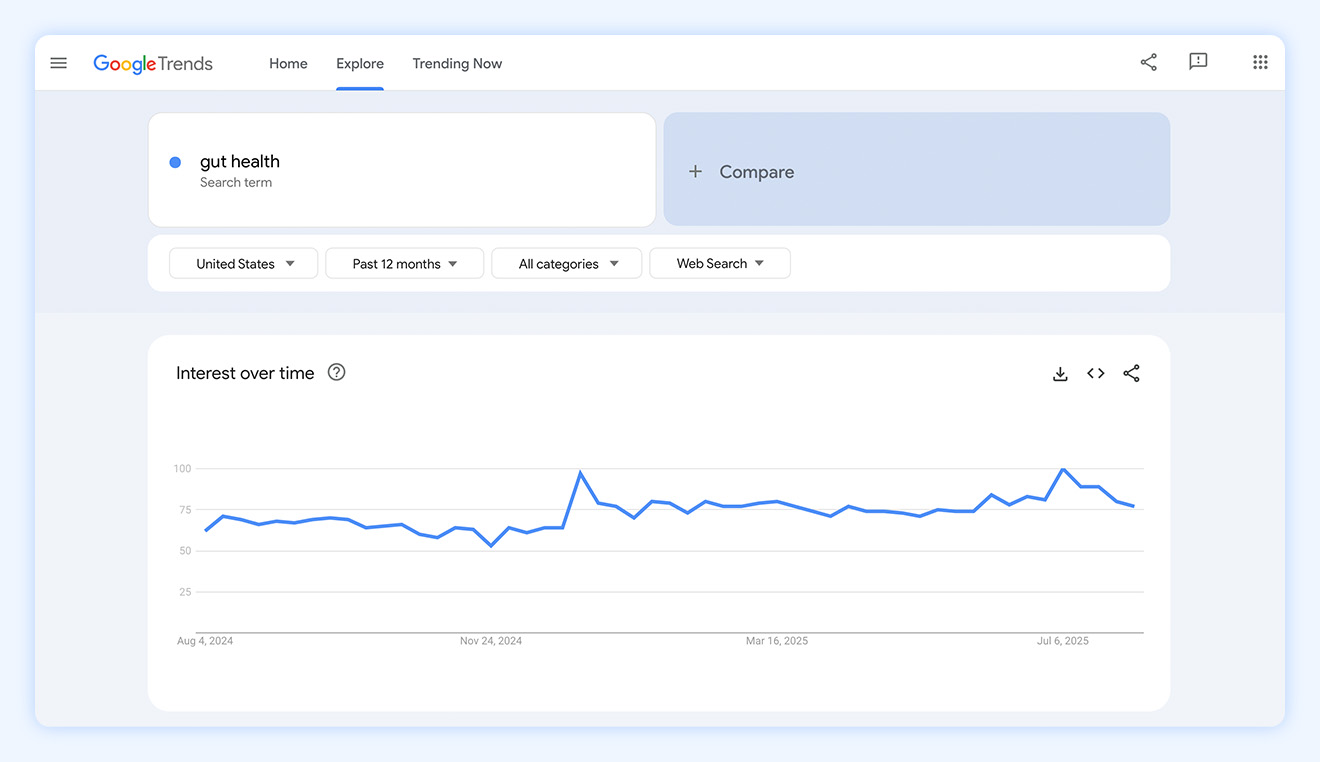
A closer look using AnswerThePublic shows that there are 86 questions people need answered about the topic.
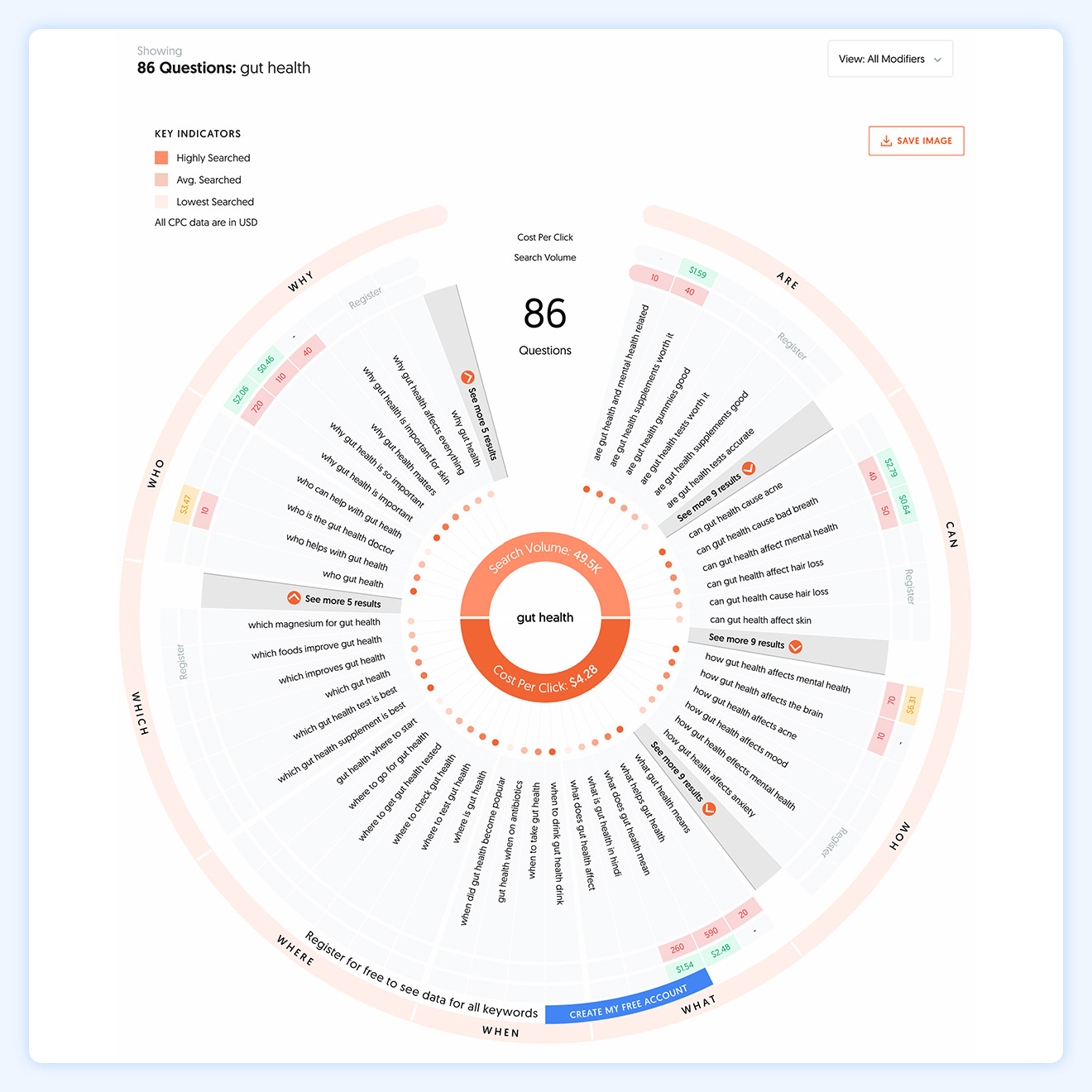
Other tools to check out include:
- ChatGPT: A great research tool that can help you generate more ideas faster
- Canva: An online design tool with free plans and templates for graphics, eBooks, guides, templates, and so much more
High profits and cheap to create
Unlike physical products, digital products are produced once and can be sold over and over again.
You never have to worry about ongoing production costs or the quality of an already-produced digital product. With low production costs, it’s easy to recoup the product costs of the initial design, making every sale after your breakeven point highly profitable.
Unlimited product possibilities
Once you start to sell digital products online, you’ll soon realize that any valuable idea that solves a problem for your audience can be packaged and sold. You’ll find that digital products can be anything from icon packs to audio files, exclusive videos, and even special effects.
Easy scale and automation
The beauty of running a digital products business is the automation capabilities. Your online store runs 24/7/365, processing orders, taking payments, and fulfilling orders in seconds. Automation requires little to no action from you while affording you all the benefits of a well-oiled and scalable business that pays with little effort on your part.
Examples of digital products to sell
The great thing about developing types of digital products to sell is that you can create different options to support your content and promote them on your platforms.
So whether you want to create a downloadable guide, a membership site, or an online course, we have the right digital product idea for you.
Most digital product ideas will fall into one of several core categories, allowing you to choose which format best suits your expertise, your audience’s needs, and your overall business goals. Consider the following digital products list to inspire your own profitable creations.
| Digital product | Why it sells |
| eBooks and guides | Offer in-depth knowledge in a portable, instantly accessible format. |
| Online courses | Let learners gain real skills at their own pace — anytime, anywhere. |
| Membership sites and apps | Build recurring revenue by offering exclusive content and a sense of belonging. |
| Podcasts | Create loyal audiences through personal storytelling and niche insights. |
| Exclusive videos | Give fans premium, behind-the-scenes, or early-access content they can’t get anywhere else. |
| Paid newsletters | Deliver curated, expert-level insights directly to readers’ inboxes. |
| Music and audio | Let creators monetize beats, sound effects, or tracks with zero shipping or inventory. |
| Downloadable documents and templates | Save people time with ready-to-use, customizable tools and resources. |
| Mobile apps | Solve specific problems or enhance daily life through on-demand functionality. |
| Video games | Tap into entertainment and escapism with unique, engaging experiences. |
| Website themes | Help users launch professional-looking sites fast, without hiring a designer. |
| Browser plugins | Improve productivity or add features people didn’t know they needed. |
| Programmer code | Offer time-saving snippets, tools, or frameworks other developers can build on. |
| Design wallpapers | Add personality to digital spaces with eye-catching, high-quality visuals. |
| Design elements (fonts, photos) | Empower creators and marketers to elevate their visual content. |
1. eBooks and downloadable guides
An eBook, short for electronic book, is typically a non-editable digital file containing a body of text and images, designed to be read on digital devices such as computers, tablets, e-readers, or smartphones.
| Why it works: eBooks deliver value in a highly accessible format. They offer creators a direct and profitable way to share knowledge and stories with a global audience. |
Understated but full of potential, eBooks are some of the most profitable digital products you can sell. You can enhance the reading experience by including elements like:
- Hyperlinks
- Search functionality
- Interactive features
While eBooks can be profitable, they may not be the best fit for everyone. Carefully consider whether an eBook is the right type of digital product for your business.
| Pros | Cons |
| Low production cost | Creation and design can be time-consuming |
| Scalable passive income potential | Saturated market makes success more challenging |
| Establishes authority | Need to have the right knowledge and experience |
Because of their design and format, eBooks are widely used for literature, educational materials, technical manuals, and more. Once you’re confident in your product, consider building your own online store to send buyers to.
💡How They Do It
Nakisha Wynn is a digital creator, blogger, and business coach. Her eBook on building a successful blog is a step-by-step walkthrough for blogging enthusiasts and sells for $25.
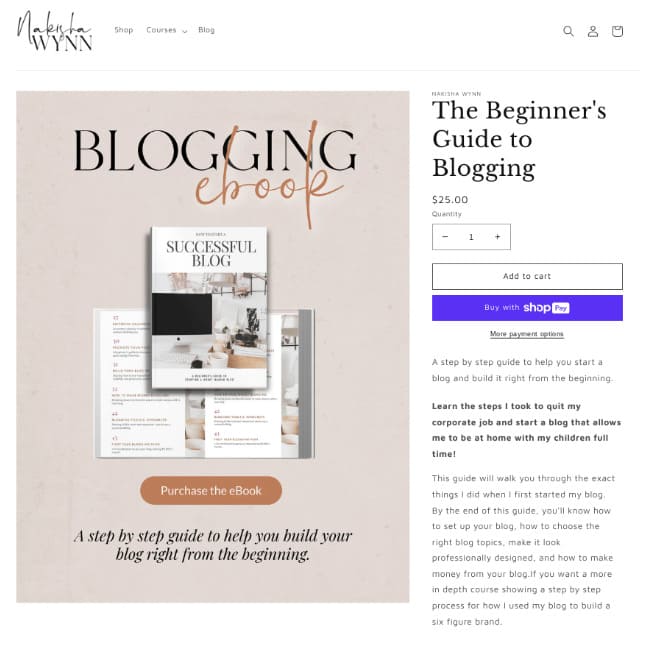
2. Online courses
An online course is a structured program of study delivered over the internet. Hosted on online course platforms like Teachable, these courses can cover a wide range of subjects and are designed to be accessible from anywhere, allowing learners to study at their own pace.
| Why it works: Online courses package specialized knowledge into a structured, engaging, and highly valuable learning experience. They empower creators to educate and transform their audience. |
Online courses usually include a combination of features, such as:
- Video lectures
- Reading materials
- Quizzes
- Assignments
- Interactive forums for discussion
And because online course platforms have lowered the barrier to entry, universities, professional organizations, and independent instructors have been able to produce a range of learning experiences, including:
- Free introductory classes: Short, often self-paced courses designed to give a taste of your content, serving as a lead magnet for your paid offerings
- Tutorials: Step-by-step guides, such as a Photoshop tutorial series
- Workshops: Interactive training sessions, like a virtual coding workshop for developers
- Cohort-based courses (CBCs): Programs where a group of students progresses through the material together on a set schedule, often with live sessions and strong community interaction
- Mini-courses: Shorter, focused courses designed to quickly teach a specific skill or concept
- Comprehensive, paid programs: In-depth courses covering a broad topic, often structured into modules, usually leading to certification or degrees
| Pros | Cons |
| Establishes expertise and reputation | Creating an entire course can be time-consuming and labor-intensive |
| Scalable passive income potential | Requires substantial background knowledge, research, and/or credentials |
| High engagement potential | Relies on participants being motivated and committed |
💡How They Do It
Magic Stream is an online learning platform with courses that teach magic tricks from coin magic to mentalism.
Students can access the courses via a monthly membership, or opt for a one to three-year membership, both of which can be cancelled at any time.
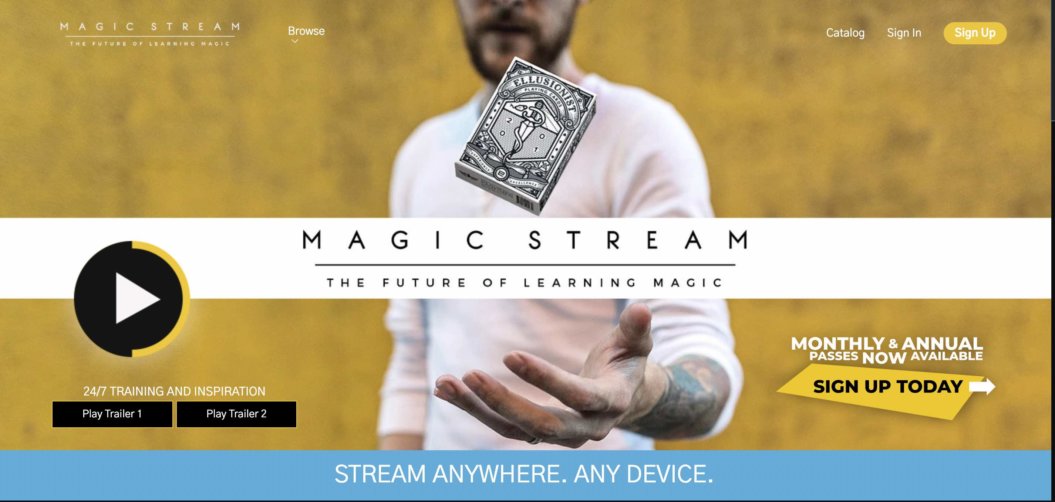
3. Membership sites
A membership site is a website that offers exclusive content, services, or products to registered members. Users pay a subscription fee rather than making a one-time purchase to access these resources, which may include educational content, community forums, webinars, premium articles, or specialized tools.
| Why it works: Membership sites cultivate a loyal community around recurring value, creating stable, predictable revenue streams. They’re centered on the human desire for connection and continuous learning within a niche, offering an exclusive and evolving experience. |
Membership sites are also designed to create a sense of community, which serves as an ongoing value-add to subscribers. Communities are often centered around a specific topic, interest, or industry, making them feel more exclusive and, therefore, worth investing in.
“Memberships perform especially well in 2025, in part because of the community element,” says Kylie Julien, Senior Video Production Specialist at Uscreen. “People want connection, which you just can’t get with a one-and-done piece of content.”
| Pros | Cons |
| Builds community | Requires ongoing content output |
| Provides a direct feedback loop | Risk of member churn means unreliable income |
| Scalable, recurring revenue | Consistent moderation and engagement needs |
Examples of membership sites include:
- Educational platforms
- Professional networks
- Hobbyist communities
- Fitness programs
The most attractive aspect of creating a membership business with a community is the revenue potential. Your membership can generate recurring revenue that increases as your community grows.
💡How They Do It
Adriene, from “Yoga with Adriene” has her own membership website called Find What Feels Good. She chose to sell online fitness courses on a subscription basis where she shares exclusive yoga videos and classes weekly.
In fact, her membership platform was considered a “Winner” digital product by prominent YouTubers Collin and Samir.

4. Podcasts
A podcast is a digital audio or video program available for download or streaming over the internet. Podcasts are presented as a series of episodes focused on specific topics or themes, such as technology, sports, news, or marketing.
| Why it works: Podcasts offer an intimate and convenient way to consume content, building strong listener loyalty and trust. They provide unique opportunities for monetization through direct listener support, premium content, and highly targeted sponsorships. |
Audience members can download each episode or stream via computer or mobile device and listen to it at their convenience. Podcasts can be a huge draw for sponsors looking to put their service or brand in front of your audience.
“Podcasts (especially video podcasts) are another digital product that I see doing well,” says Julien. “Platforms like YouTube and Spotify are paying more attention to podcasting and offering more tools for creators, so it’s a solid time to take advantage of new opportunities.”
You can use hosting services like Buzzsprout, Podbean, and Spotify to store and distribute their episodes, or YouTube, making it easy for listeners to access content via various podcast apps and platforms.
| Pros | Cons |
| Multiple ways to monetize content | Time-consuming and technical production process |
| Convenient, on-the-go consumption increases accessibility | Oversaturated market means discovery is competitive |
| Foster personal connections with listeners | Hard to connect with listeners in real-time |
💡How They Do It
Ali Abdaal is a former doctor turned YouTuber, Podcaster, entrepreneur, and author. His podcast, Deep Dive With Ali Abdaal, involves interviews with creators, and entrepreneurs. He monetizes his shows through sponsorship deals with brands that are aligned with his message, business, and audience.

5. Exclusive videos
Exclusive videos are video content created and made available for a specific audience, typically behind a paywall or as part of a subscription service. These videos are not accessible to the general public and are usually offered as premium content to subscribers, members, or paying customers.
| Why it works: Exclusive videos offer a premium visual experience that audiences value, creating a strong incentive for direct monetization. Through exclusive video content, creators can deliver unique insights, provide education, or entertain viewers in a dynamic and engaging format. |
Exclusive videos can include:
- Webinar recordings: Live events that have been recorded and made available on demand
- Tutorial videos: Single videos you can sell alone for a one-time fee
- Live streams: Live events that are streamed to an audience
- Interviews: Conversations with subject matter experts that are recorded or streamed live
- Behind-the-scenes footage, bloopers, and vlogs: Footage that gives your audience a look at how your business runs behind the scenes
- Bonus content/PVOD: Content not shared through your typical channels and is made available for a premium
| Pros | Cons |
| Versatile content medium | Higher production costs for equipment, software, and editing |
| Encourages viewer engagement | Large video files require sufficient storage and hosting solutions |
| Direct monetization for most valuable content | Marketing efforts are greater to encourage sales |
💡How They Do It
Your Book of Memories teaches people how to create their own DIY albums and scrapbooks.
Their high-quality instructional videos go over everything you need to create your own album, from material lists to step-by-step instructions
You can purchase a single class or pay monthly to access all of their classes.

6. Paid newsletters
A paid newsletter is a subscription-based email service where subscribers pay a fee to receive exclusive content. Newsletters offer valuable, in-depth information, insights, or resources people are willing to pay for because of the premium associated with your intellectual property.
| Why it works: Paid newsletters provide curated, exclusive value straight to the subscriber’s inbox, fostering a connection with the creator using consistent, high-quality content to build loyal communities and generate reliable recurring revenue. |
For example, a financial analyst might create a paid newsletter offering detailed stock market analyses and investment tips, while a fitness expert might provide customized workout plans and nutritional advice.
| Pros | Cons |
| Recurring revenue through a subscription model | Requires consistent output of high-value content |
| Relatively inexpensive to produce | Income depends on open rates and can be affected by subscriber churn |
| Builds authority and fosters trust | Lacks the interactive engagement of other product ideas |
Lenny’s Newsletter is dedicated to tackling reader questions about product, growth, career growth, and anything else stressing you out at the office. It offers 4 plans, one of which is a free plan.

7. Music and audio recordings
Music and audio recordings are sound files that have been captured, processed, and stored in a digital format. Once digitized, the audio can be edited, mixed, and distributed using various digital platforms and formats. If you’re an artist, you can create a collection of recordings and sell them online.
| Why it works: Producing music and other audio files allows creators to directly monetize their content and provide highly versatile assets for other creators, who can usually access them immediately after purchasing. |
Key digital product ideas for artists and creators in this space include:
- Instrument samples: Sound clips of instruments, such as drum kit samples
- Music software plugins: Tools for music production, like a reverb plugin
- Stock music: Royalty-free music tracks, including background music for videos or podcasts
- Sound effects: Audio effects for various media, like explosion sound effects
- Intros and outros: Pre-designed opening and closing audio for podcasts, videos, and other media
- Full albums or singles: Direct sales of your original music, offering more revenue than traditional streaming platforms
| Pros | Cons |
| Can appeal to individual consumers and professional creators | Audio files may be at risk of piracy |
| Digital distribution has a global reach | May be difficult to stand out in a competitive market |
| Artists can directly earn revenue from their content | Difficult to generate reliable revenue |
💡How They Do It
FaderPro offers electronic music production courses taught by the most successful artists, producers and DJs.
They teach how to create your own signature sound and get all the secrets to being successful in the business.
You can choose a course to purchase or sign up for a monthly subscription to access all of their courses and exclusive content.

8. Downloadable documents, templates, and presets
Downloadable documents and digital templates are digital files people can download and use. They typically take different formats like PDF, DOCX, PPTX, or XML and serve as pre-designed frameworks or structures that can be customized according to user-specific needs.
| Why it works: Downloadable content provides immediate, practical solutions that save users significant time and effort, leveraging the creator’s expertise to deliver high value at an accessible price point. |
Examples include:
- Worksheets: Educational practice sheets, such as math worksheets for kids
- Plans: Predefined outlines or strategies, like digital planners or business plan templates
- Checklists: Lists for task management, such as an event planning checklist
- Guides: Instructional documents, like a home DIY guide
- Photography presets: Photography filters with specific styles, like rainy day presets
- Resume/CV templates: Professionally designed layouts that help job seekers create impressive resumes quickly
| Pros | Cons |
| High demand and low production costs make these assets highly profitable | May be undervalued by some consumers |
| Generate passive income once the asset is created and available | Templates may lack the customization consumers want |
| Nearly infinite possibilities for content across industries | Easily shared once downloaded, meaning the risk of piracy is high |
💡How They Do It
Star seller, SimplePTT sells over 600 PowerPoint templates on their Etsy store. They include different styles, like pastel tones and minimal look, and sell templates for different purposes, from reports to business templates.
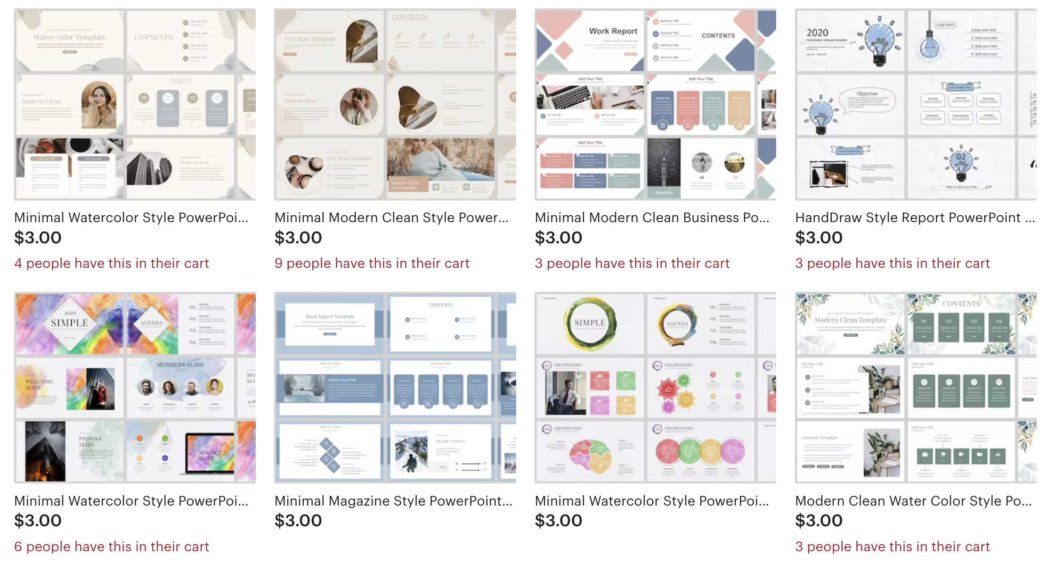
9. Mobile apps
The mobile app market alone is set to be worth over $260 billion by 2030. They can range from mobile applications used for social media, productivity, gaming, or education to smart TV entertainment apps and desktop applications like video editors or graphic design tools.
| Why it works: Mobile apps offer an integrated, interactive experience directly on users’ personal devices, enabling constant engagement, fostering user loyalty, and providing opportunities for recurring revenue. |
As a creator, there are ways for you to get into the app market. You could develop your own app or lease one. What matters most is how you plan to monetize your app. This can be with ads, product sales, affiliate links, or subscriptions.
Types of apps you can leverage include:
- Branded apps with video libraries: Over-the-top (OTT) apps built around your content, like a fitness instructor’s app with workout videos and meal plans)
- Photo editing apps: Tools for enhancing images with filters, effects, and editing capabilities
- Productivity tools: Apps designed to help users manage tasks, organize information, or streamline workflows
- Utility apps: Tools that perform specific functions, such as calculators, unit converters, or weather trackers
- Content consumption apps: Providing access to exclusive articles, podcasts, or digital magazines
| Pros | Cons |
| High potential for recurring revenue | Higher development and maintenance costs than other products |
| Immersive and engaging with opportunities for scalable community growth | May require substantial promotion and marketing to stand out |
💡How They Do It
Abundance Plus is a homesteading community that offers lessons on how to grow your own food. Founder, Justin Rhodes, has released apps that users can download and use to join the community starting at $59.99 per month. Discover how they doubled their membership revenue with apps on Uscreen, here.
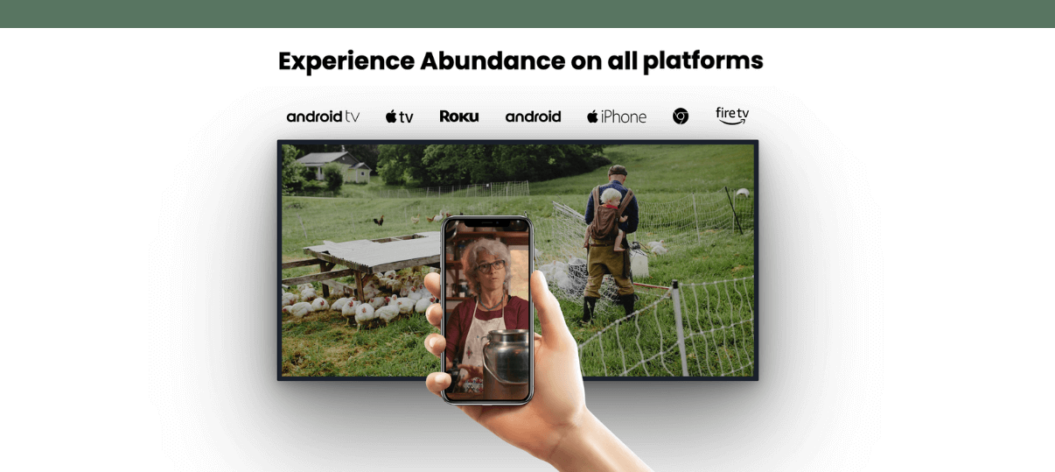
10. Self-paced workout programs
Self-paced workout programs are digital guides, videos, or combination packages that provide structured exercise routines individuals can follow at their own convenience. Unlike live classes or personal training, these programs offer more flexibility, allowing users to start, pause, and resume their fitness journey on their own schedule and at their preferred location.
They typically include detailed instructions, demonstrations, and tracking sheets to help users achieve specific fitness goals.
| Why it works: Selling self-paced fitness programs can give consumers expert guidance they can use on their own time, giving them a flexible starting point and empowering them to achieve health goals on their terms. Fitness professionals can share their expertise in a scalable way, generating consistent income from a global audience. |
Examples include:
- Video-based programs: A series of workout videos demonstrating exercises, often structured into daily or weekly routines
- PDF workout guides: Downloadable documents outlining exercises, sets, reps, and form instructions, sometimes with images
- Hybrid programs: Combinations of videos for demonstrations and PDFs for tracking and additional information
- Specialty programs: Focused on specific goals like strength building, weight loss, yoga, Pilates, or marathon training
- Nutrition guides: Often bundled with workout programs to offer holistic health solutions
You can also monetize fitness videos you’ve already recorded or repurpose some into your self-paced programs, depending on the amount of content you have available.
| Pros | Cons |
| Establishes the creator as a trustworthy authority in the fitness space | Creating detailed video or written programs can be time-consuming |
| Minimal requirements for equipment and tools, depending on the guide | Users may lose motivation without direct accountability or community |
| Doesn’t require ongoing content creation | Highly competitive and requires substantial differentiation |
11. Workout challenges or programs
Workout challenges or programs, often delivered as a combination of PDFs and video content, provide structured, time-bound fitness journeys. These digital products create a sense of accountability and community, guiding users through a series of exercises, meal plans, and motivational content, typically over several weeks or months.
| Why it works: Creators in the fitness space can engage their followers with daily content, private communities, and products centered on motivation and accountability. |
The programs can take different forms, including:
- Daily workout videos: Guided exercise sessions or live stream fitness classes for each day of the challenge
- PDF guides: Downloadable documents for exercise plans, nutrition advice, progress tracking, and educational content
- Meal plans and recipes: Curated dietary guidance to complement the fitness goals
- Live Q&A sessions: Periodic live virtual sessions with the instructor for direct interaction and support
- Private community access: Exclusive forums, Facebook groups, or Discord servers for peer support and motivation
| Pros | Cons |
| High engagement and retention potential | Requires consistent content creation |
| Opportunity for community growth and support | Dependent on fitness instructor’s presence and charisma |
| Involved structure lends itself to premium prices compared to self-paced options | Ongoing sales requires successfully selling the value of the program |
12. Video games
Gaming isn’t dying out anytime soon. Research shows that the mobile gaming industry generated $92 billion in revenue in 2024 — a 49% market share of the global gaming industry’s total revenue. Because games span various genres and formats, from action and adventure to simulations and puzzles, there’s an opportunity to cater to diverse interests and age groups.
| Why it works: Creating a video game is a labor of love that can ultimately result in an immersive, entertaining experience as a platform for creativity and engagement. Different models offer diverse opportunities for revenue generation. |
Video games can also be accessible through different devices, like smart TVs, PCs, or smartphones. If you’re a game developer, you can create an indie game and sell it online.
| Pros | Cons |
| Highly engaging and creative type of content | Long, labor-intensive development cycle |
| Earn revenue through sales, in-app purchases, subscriptions, advertising, or merchandise | High development, testing, and distribution costs |
| Easily recognizable format to the gaming audience | Extremely competitive market requires successful marketing and promotion |
💡How They Do It
Sunset Solitare is an indie game created by Johan Peitz, with four different solitaire games and unlockable difficult levels, sold for $4.95.
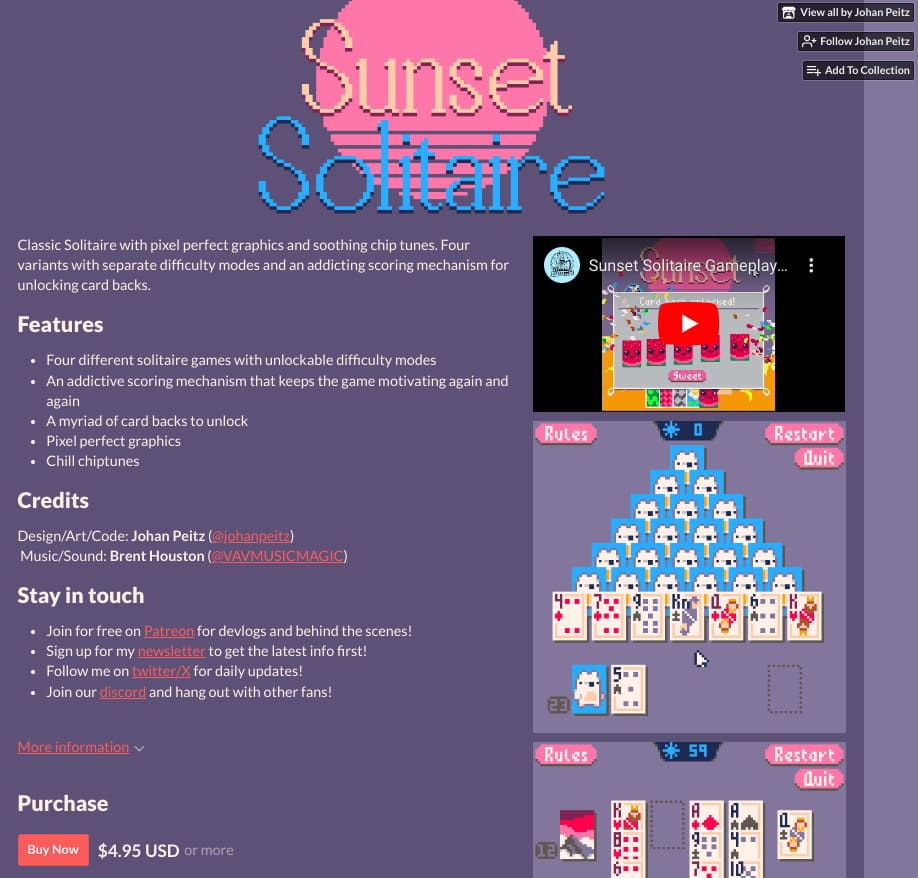
13. Website themes
A website theme is a pre-designed template or set of templates based on a specific look, feel, and functionality of a website. It includes various elements such as layout, color schemes, fonts, and styles that form a cohesive design framework for a website without needing to build it from scratch.
| Why it works: These instant, professional design solutions can save users immense time and effort when building out a website. They allow individuals and businesses to launch visually appealing and functional websites without needing coding expertise or hiring expensive designers. |
If you’re a website designer and developer, you could produce themes for popular content management systems (CMS) like:
- WordPress: Pre-built designs for WordPress websites, ranging from blogs to e-commerce stores
- Shopify: Customizable templates for online stores, designed to enhance product presentation and user experience
- Squarespace: Easy-to-use layouts for a range of sites on Squarespace
- Video CMS: Layouts for video display, channel pages, and content organization, plus video upload and playback features
- /CSS: Standalone web templates for users who prefer to build websites from scratch or with minimal CMS integration
| Pros | Cons |
| Scalable passive income opportunity | Requires technical skill with coding and different CMS platforms |
| Demonstrates expertise and authority in your field | Often requires continuous updates and maintenance |
| Appeal to a wide range of uses and audiences | Protecting your code from piracy may be challenging |
💡How They Do It
ThemeFusion is an independent WordPress theme developer that sells themes on Theme Forest. One of their most successful themes, Avada, has over 900k sales and retails for $69.
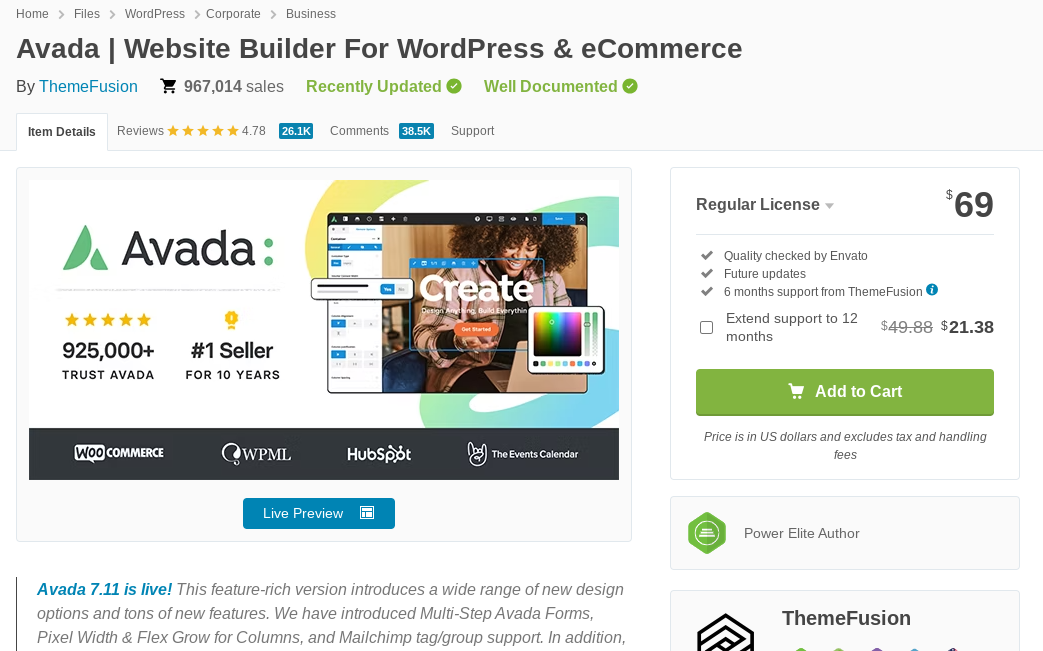
14. Browser plugins
A browser plugin, also known as a browser extension or add-on, is a small software application that adds specific features or functionalities to a web browser. Plugins often enhance the browsing experience by providing additional tools, customization options, or integrations with other services directly within the browser environment.
| Why it worksEnhance the efficiency and customization of users’ daily online activities through browser plugins. Original plugins can provide immediate utility by addressing pain points or adding desired features to users’ browsing experience. |
Examples include:
- Productivity tools: Plugins that help with task management, note-taking, time tracking, or data extraction (e.g., tab manager, Pomodoro timer)
- Security and privacy enhancers: Tools that block ads, trackers, or enhance VPN capabilities (e.g., ad blocker, password manager)
- Content enhancers: Plugins that provide richer media experiences, content curation, or specific formatting for websites (e.g., screenshot tool)
- SEO and marketing tools: Extensions for web developers or marketers that offer quick access to analytics, keyword research, or page analysis
- Niche utility tools: Plugins designed for very specific purposes, like a color picker for designers or a video downloader
| Pros | Cons |
| Allows creators to solve specific problems and establish authority | Requires complex development and technical skills |
| Scalable revenue through one-time purchases, subscriptions, or freemium models | May need to be adjusted and updated to be compatible with other browsers |
| Relatively easy to launch and update once developed |
💡How They Do It
Tool4Seller created a browser plugin that helps Amazon eCommerce entrepreneurs conduct fast and reliable research online.
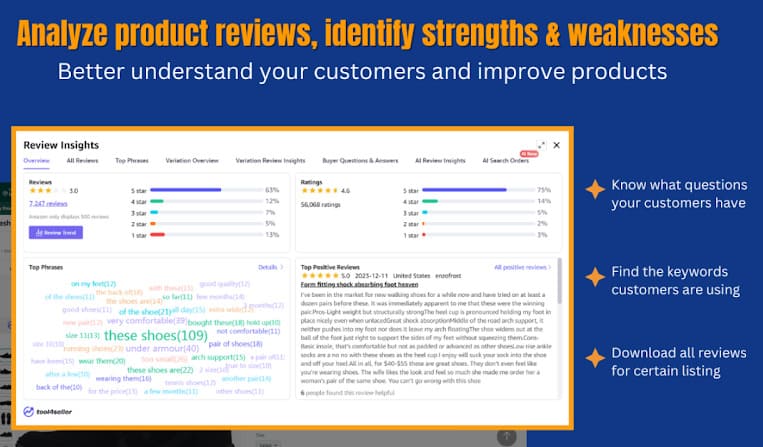
15. Programmer code
If you’re a programmer, you can sell code you’ve produced. Code exists in various forms, from high-level languages like Python and JavaScript to lower-level languages like C and assembly code.
| Why it works: Code is an incredible resource because it reduces development cycles and gives users access to complex features without requiring deep expertise in every domain. Skilled programmers can help their customers save time and money by providing ready-to-use or easily modified code for different applications. |
Because each type of code serves a specific purpose, whether it’s for creating interactive user interfaces, processing data, implementing algorithms, or integrating with external systems, chances are other coders are searching for a shortcut to building their programs.
Examples include:
- Code snippets: Small, focused pieces of code that perform a specific task, like a JavaScript function for form validation
- Libraries and frameworks: Collections of pre-written code that provide reusable functions, classes, or structures
- APIs (application programming interfaces): Code that allows different software applications to communicate with each other, or custom API wrappers that simplify complex integrations
- Templates and boilerplates: Pre-built project structures or starter kits that include common configurations and code patterns for specific applications
- Algorithms: Implementations of complex logic for specific computational problems, like a custom sorting algorithm or machine learning mode
💡How They Do It
Codester is a marketplace for all types of code in various programming languages. You can find just what you need to complete a project and make your purchase in under a minute. Alternatively, you can create your own website and sell your code there.
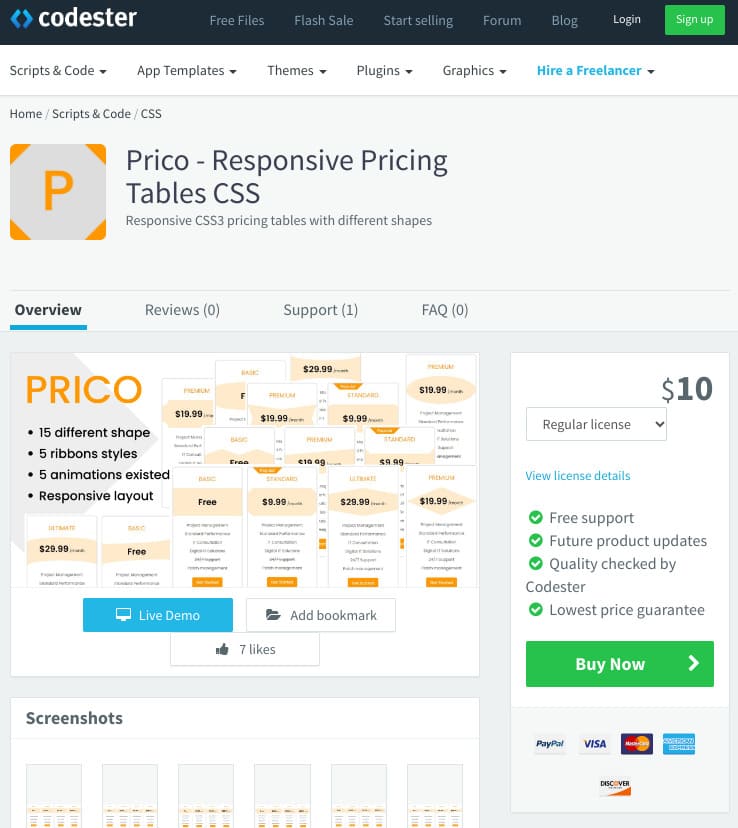
16. Design wallpapers
Wallpapers are digital images or designs specifically created for use as backgrounds on devices such as computers, laptops, tablets, and smartphones. Digital wallpapers can also be static images or dynamic designs and can be sold individually or as bundles.
| Why it works: Especially popular among artists and other content creators, digital wallpapers allow users to personalize their digital devices and express their individuality with minimal effort, tapping into aesthetic desire. |
Wallpapers range from abstract art and intricate illustrations to realistic photography and themed designs, like seasonal aesthetics, pop culture, and nature.
| Pros | Cons |
| High demand for personalization makes these products desirable | Low price point means profit is dependent on high sales volume |
| Digital files have a low production cost | Many free and paid options available, making competition steep |
| Easily distributed via digital marketplaces | May be difficult to attract attention from potential users |
💡How They Do It
MNGOcreatives produces wallpapers, backgrounds, and overlays which they sell on Etsy. This bundle includes 10 wallpaper designs with various aspect ratios.
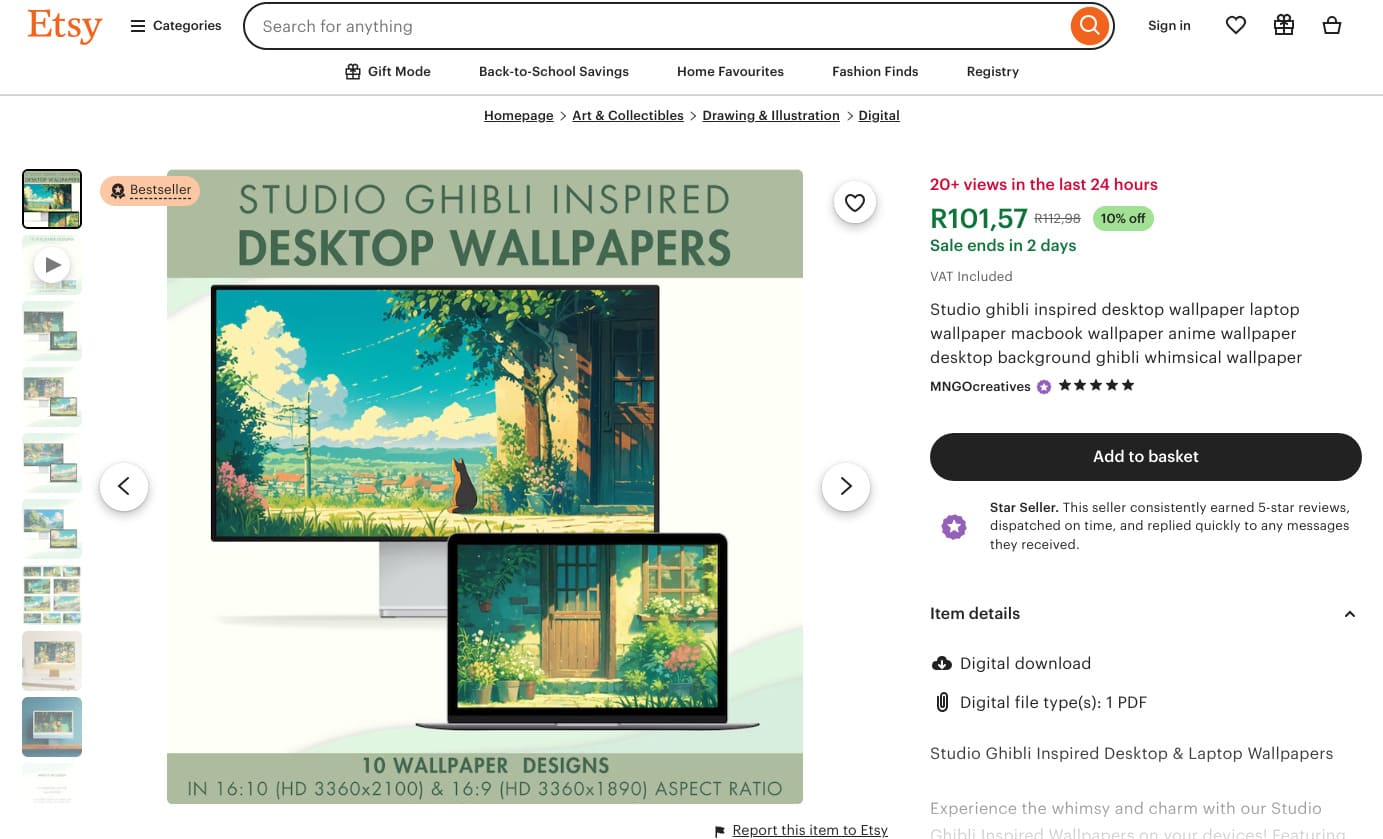
17. Design elements
Design elements are digital components that help enhance the visual and functional nature of a product’s interface and user experience. Fonts, icons, and stock photos are three very popular types of design elements, and if you can produce them, you can sell them.
| Why it worksEven those in creative professions may not have every skill they need to be successful, so offering pre-made, high-quality design elements can make creators’ lives that much easier. Offering these products also establishes your presence as a reliable, professional designer, boosting your reputation. |
Designed to save creators time, ensure professional quality, and provide unique visual components, digital design elements may include:
- Digital fonts: Unique typefaces for use in graphic design, branding, and web design
- Stock photos: High-resolution photographs covering various subjects, themes, and styles, typically royalty-free for commercial use
- Icons: Small graphical symbols used in user interfaces, websites, and presentations
- Vector graphics: Scalable illustrations or artwork like clip art that can be resized without loss of quality
- Textures and patterns: Digital files that can be overlaid onto designs to add depth, realism, or aesthetic appeal
- Brushes: Custom brushes for digital painting or illustration software
- User interface (UI) kits: Collections of UI components like buttons and navigation elements to speed up web and app design
| Pros | Cons |
| High in demand for creative industries | Requires specific design skills and technical experience |
| Can be sold individually or in bundles | Requires strong differentiation in a competitive market |
| High-quality assets can boost the creator’s reputation | May need to manage licensing agreements for certain assets |
💡How They Do It
Myicons is an independent icon creator that sells minimalist icons on Creative Market. Myicon typically creates large icon bundles, like this one with over 14k icons retailing for $299.
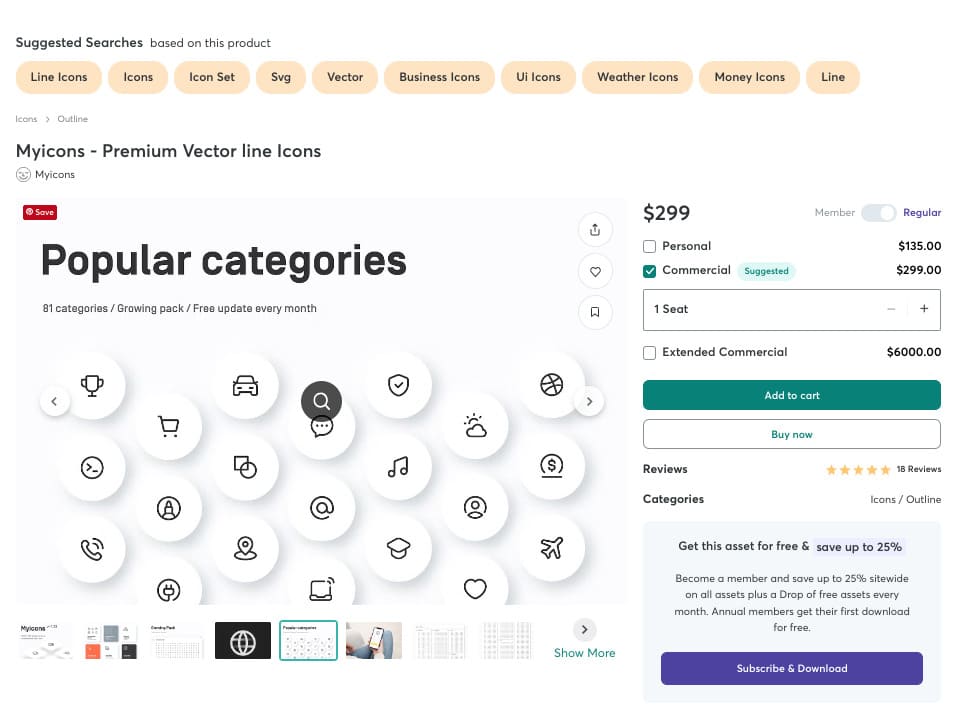
18. Meditation recordings
Meditation recordings are digital audio files designed to guide listeners through mindfulness exercises, relaxation techniques, or focused contemplative practices.
These recordings range from short, guided meditations to longer, immersive soundscapes or visualizations. They serve as a portable and accessible way for individuals to incorporate mindfulness into their daily lives.
| Why it works: The mental health market is ever-expanding, and offering instant access to stress reduction and relaxation through meditation is a great way for some creators to connect with and inspire their communities. |
Depending on the creator’s experience, meditation recordings may look like:
- Guided meditations: Voice-led sessions that direct listeners’ attention through specific techniques, such as breath awareness or body scans
- Soundscapes: Ambient audio environments (e.g., nature sounds, instrumental music) designed to aid relaxation, sleep, or focus without spoken guidance
- Affirmation tracks: Recordings that repeat positive affirmations to help reshape thought patterns
- Sleep stories: Calming narratives designed to help listeners drift off to sleep
- Visualization exercises: Guided audio journeys that encourage listeners to imagine specific scenarios for therapeutic or goal-setting purposes
| Pros | Cons |
| Relatively inexpensive to record and produce | Listeners may prefer content from certified or recognizable creators |
| Scalable and accessible across various platforms | One-way interactions limit community building outside of comments and forums |
| Audio and editing need to be high-quality to be effective |
19. Coding bootcamp materials
Coding bootcamp materials are comprehensive digital packages designed to teach programming skills or software development methodologies, mirroring the structured curriculum of an intensive coding bootcamp.
| Why it works: Providing coding bootcamp materials gives consumers access to the resources they need to learn in-demand technical skills. They offer an alternative to traditional in-person bootcamps, providing flexible yet robust paths for aspiring developers. |
These materials may include:
- Video lectures: In-depth instructional videos covering programming concepts, frameworks, and tools
- Coding exercises: Practice problems with accompanying solutions to reinforce learning
- Mini-projects and capstone projects: Hands-on assignments that allow learners to apply their skills in real-world scenarios
- Cheatsheets and reference guides: Quick-access documents for syntax, commands, and best practices
- Code templates: Pre-written code to kick-start projects and focus on core learning
- Interview prep materials: Resources like common interview questions, resume templates, and portfolio guidance
- Private community access: Forums or chat channels for peer support and instructor Q&A
These digital products appeal to individuals looking to switch careers, upskill, or land their first developer job without the time commitment or cost of a traditional bootcamp. They are highly practical, project-oriented, and often focus on current industry demands.
| Pros | Cons |
| High-demand resources can be priced accordingly | Requires significant expertise and experience to create |
| Scalable product can be distributed globally | Often demands regular updates to keep up with technology |
| Needs a platform with complex capabilities like code editors |
20. Custom Notion dashboards
Pre-built templates for Notion, a popular all-in-one workspace application, are designed to help users organize information, manage projects, track habits, or streamline workflows.
| Why it works: Productivity resources like Notion templates appeal to a wide range of consumers, so whether you specialize in specific niches or take a broad approach, there’s a lot of potential for sales. Templates are especially useful to new users, but if you’re familiar with the Notion platform, you can create products that go beyond general resources and appeal to experienced users as well. |
These digital products go beyond basic templates and allow users to save countless hours of setup time. Ideas include:
- Productivity hubs: Dashboards for daily planning, task management, goal tracking, and habit building
- Content creation systems: Templates for managing content pipelines, editorial calendars, and ideation processes for bloggers, YouTubers, or social media managers
- Project management dashboards: Comprehensive systems for tracking tasks, deadlines, team collaboration, and client projects
- Personal finance trackers: Templates for budgeting, expense tracking, investment portfolios, and financial planning
- Student dashboards: Systems for academic planning, note-taking, assignment tracking, and study schedules
- Customer relationship management (CRM) templates: Simple systems for freelancers or small businesses to manage client interactions
| Pros | Cons |
| Relatively easy to create with the right skill set | Platform-specific product may limit potential reach |
| Satisfies a growing demand in the productivity niche | Users may want ongoing support and guidance |
| Users may be willing to spend money to make their lives easier |
21. TikTok content calendars
Content creators can use TikTok content calendars to organize and plan their TikTok video production. These calendars can be tailored to help creators maximize reach and engagement on the fast-paced platform.
| Why it works: These specialized calendars save creators time and empower them to navigate the platform’s unique trends and demands. With the guidance of a well-constructed content calendar, creators can more confidently produce engaging content to stay relevant and visible in a dynamic social media landscape. |
The most effective examples go beyond seasonal ideas and may instead feature:
- Trending projections: Insights into upcoming trends and viral audio to help creators plan ahead
- Content pillars: Frameworks to help creators diversify their content around core themes
- Hooks and CTAs: Collections of engaging video opening lines and calls to action to boost performance
- Posting frequency guidelines: Recommendations for posting frequency depending on the creator’s niche, audience, and goals

You can opt to design a weekly or monthly calendar depending on your familiarity with the platform and current trends, as well as how often you expect to update your products.
| Pros | Cons |
| Fairly low production costs to create calendars and other resources | Requires constant attention and updates to keep up with TikTok trends |
| Well-researched products establish the creator as reputable | Limited reach to TikTok content creators |
| Perceived value may fluctuate with trends and best practices |
22. Social media post templates
Pre-designed graphic layouts or written frameworks can help individuals and businesses create engaging and visually consistent content across various social media platforms.
| Why it works: Accessible, professional-quality templates streamline the process of social media posting without compromising aesthetics, saving creators time and energy. These templates are especially useful for creators without digital design skills. |
These digital products include customizable designs for platforms like Instagram, Facebook, Pinterest, and LinkedIn, along with pre-written caption ideas or strategic prompts.
| Pros | Cons |
| Relatively easy and inexpensive to create | Requires design skills and software |
| Customizable templates can be sold repeatedly with minimal revisions | Saturated market means standing out is challenging |
| May need updates to align with platform changes |
23. Lesson plans for teachers
Digital lesson plans outline the objectives, activities, materials, and assessments for specific educational topics or units.
These ready-to-use frameworks for educators save them significant time in curriculum development and classroom preparation, with opportunities to customize for their students and teaching styles.
| Why it works: Lesson plans provide a starting point for busy teachers to structure their lessons. They allow teachers to ensure an engaging and effective learning experience for their students without creating their curriculum from scratch. |
These lesson plans can take different forms, including:
- Full unit plans: Comprehensive plans covering an entire topic or curriculum unit, often spanning several weeks
- Daily lesson outlines: Detailed plans for individual class periods, including objectives, activities, and materials
- Activity kits: Collections of engaging exercises, games, or hands-on activities to support specific learning outcomes
- Worksheet bundles: Printable or digital worksheets, quizzes, and assessment tools
- Themed resource packs: Collections of materials for special events, holidays, or interdisciplinary studies
| Pros | Cons |
| A creative way to engage with and help followers | Requires familiarity with different pedagogies and subjects |
| Teachers often seek time-saving, high-quality resources | Limited audience means fewer opportunities for sales and engagement |
| Lesson plans typically require minimal updates over time |
24. Digital workbooks or activity books
Interactive digital files range from professional development to entertainment, offering engaging activities, exercises, or prompts for readers. These books encourage participation by allowing users to type directly into the document, mark checkboxes, or follow guided instructions.
| Why it works: Whether for fun or personal growth, digital workbooks and activity books are an engaging way for users to learn something new, from self-discovery to marketable skills. Compared to static files, interactive media may have a higher perceived value to consumers. |
These digital products can cover a lot of ground, allowing different creators to design and distribute interactive content that aligns with their brands. Examples include:
- Skill-building workbooks: Exercises for learning a new language, mastering a software program, or improving writing skills
- Personal development journals: Guided prompts for self-reflection, goal setting, gratitude, or emotional intelligence
- Activity books for kids: Educational games, puzzles, coloring pages, or learning exercises in a digital format
- Business planning workbooks: Guided templates for developing business strategies, marketing plans, or financial forecasts
- Creative prompts: Digital sketchbooks, writing prompts, or photography challenges
- Event planning workbooks: Step-by-step guides with fillable sections for organizing events like weddings, parties, or conferences
| Pros | Cons |
| Fosters higher levels of engagement than other products | Engagement is often restricted to the product itself rather than the creator or community |
| Can be created with common software like Adobe or Canva | Requires professional design and layout skills |
| Certain topics may appeal to a narrow audience, while others may be in a saturated market |
25. Digital business cards
Shareable web pages or files are designed to replace physical business cards, offering a modern and eco-friendly way to exchange contact information.
| Why it works: Compared to traditional business cards, digital options are a cost-effective, eco-friendly, and dynamic solution. Creating customizable templates allows users to have a professional contact card with the information they want — without the need for design skills. |
These digital business cards tend to contain the individual’s:
- Website link
- Social media profiles
- Portfolio
- Phone number
- Email address
Some digital cards may also feature QR codes or virtual contact files (VCFs).
| Pros | Cons |
| Appeals to cost-conscious and environmentally friendly individuals | May not appeal to those who prefer the traditional look and feel of business cards |
| May be compatible with data tracking and analytics | |
| Digital cards can contain more information than traditional options |
Other ideas for digital products
Still looking for inspiration? Here are over 35 additional niche digital product ideas to spark your next launch, many of which you can create with little more than your own expertise, creativity, or existing content.
Video-centric and creator tools
- Astrology or tarot readings (PDF or video format)
- Interactive quizzes or personality tests
- Email swipe file collections
- Freelance proposal templates
- Legal contract templates for freelancers
- Event planning kits
- Travel itineraries or guides
- Real estate marketing kits
Education, coaching, and kids’ content
- Kids’ educational worksheets
- Custom maps or infographics
- Recipe cards or digital cookbooks
- Printable planners
- Journaling templates
- Virtual vision boards
- Affirmation card decks
- Guided journaling prompts
Design, branding, and digital assets
- Canva templates
- Google Slides or PowerPoint templates
- Resume or cover letter templates
- UX/UI design kits
- Custom icon sets
- Brand style guide templates
- Product mockup files (for apparel, packaging, etc.)
- Instagram story highlight covers
- Zoom background packs
- Influencer media kit templates
Media, music, and creative packs
- Music loops or sample packs
- Voiceover packs or narrations
- Clip art or sticker sets
- Lightroom presets
- Photoshop brush packs
- Stock photography
Printables, crafts, and lifestyle products
- Craft patterns or sewing templates
- Digital scrapbooking kits
- Digital art commissions
- Excel budgeting spreadsheets
- Scriptwriting templates or tools
- Screenwriting or novel-writing outlines
As you start to expand your digital product portfolio and audience, evaluate what your audience really wants. Consider bundling certain products that align with your customers’ goals for added value.
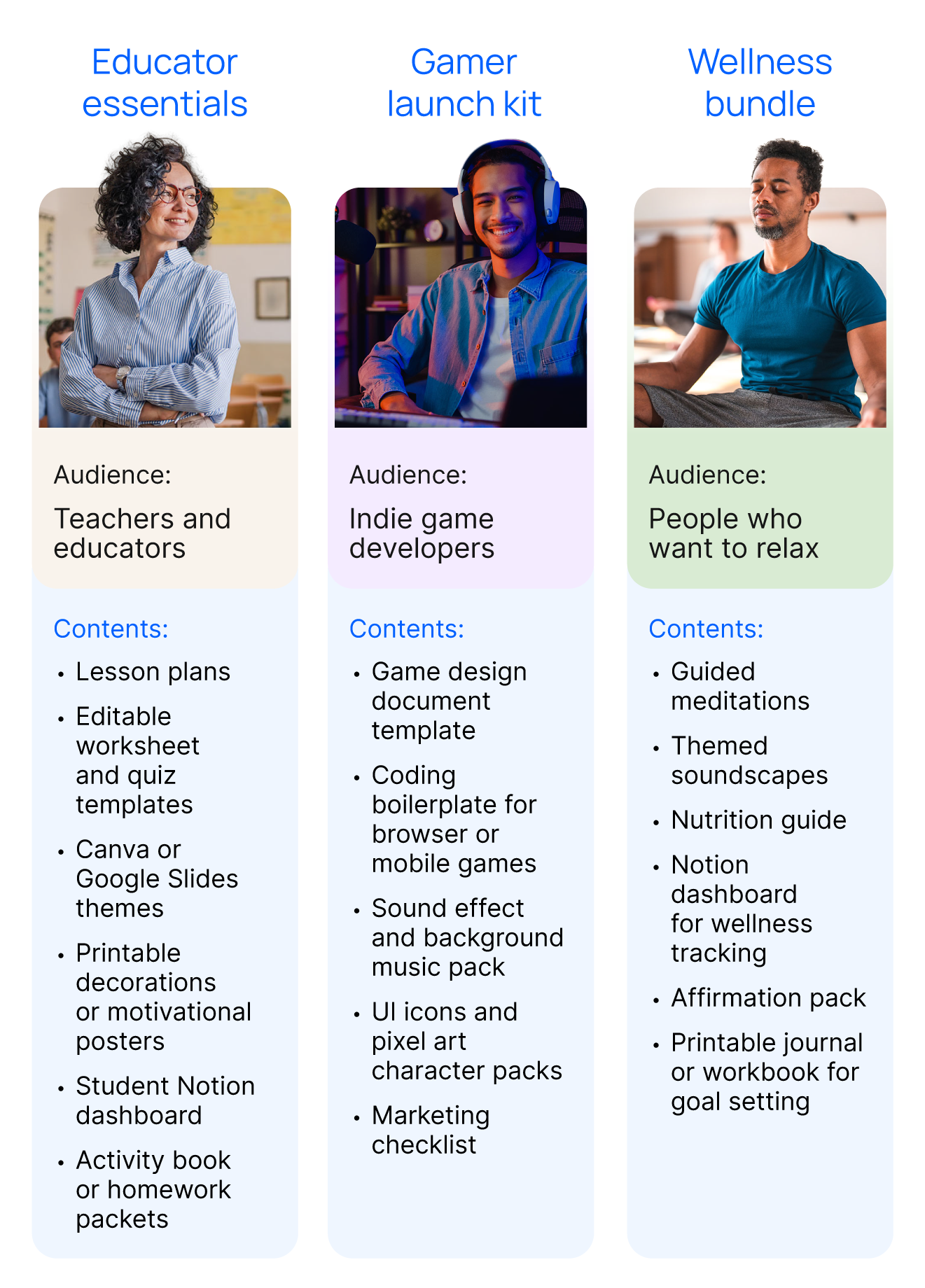
How to sell digital products
Creating your digital products is only the first step of the process. Before you put them on the market, make sure you’re making products your audience will actually be interested in.
| “Do some audience research like a survey or polls before creating your first digital product,” Julien says. “What you think your people want and what they actually want may be different. Surveying in advance can help you avoid that mismatch.” |
Once you’ve settled on the right products, you can start thinking about how to sell them. While there’s no one right way to sell digital products online, there are proven paths that successful creators tend to follow. Here are five of the top considerations to guide you:
1. Choose the right platform for your product
The best platform will depend on the type of product you’re selling and the level of control you want over your business.
All-in-one platforms are built specifically for creators and entrepreneurs with features for hosting content, processing payments, and managing your customer base. But if you want a more specialized platform or a simple solution, these options may be overwhelming.
Alternatively, marketplaces like Etsy or Creative Market are great for discoverability and have built-in audiences, but you’ll often face more competition and a less direct relationship with your customers.
2. Set up your pricing and payment structure
Your pricing should reflect the value you offer, not just the time you spent creating the product. A one-time purchase model works well for items like eBooks or templates, which are single, downloadable assets.
But a subscription model may be better for digital products that offer ongoing value, like a fitness program or a community membership. Subscription models can generate a more stable and predictable income as long as you continue providing buyers with enough value.
You can also consider offering different pricing tiers and benefits to appeal to a wider range of customers.
3. Build a high-converting landing page or storefront
Your digital storefront is the place where you make your pitch and close the sale. A well-designed page should have all of the following:
- A compelling headline that clearly states your value proposition
- A concise explanation of what your product does
- A clear CTA that tells customers what to do next
- Social proof, like testimonials and expert endorsements, to build trust and credibility
- High-quality visuals, whether product mockups or a professional video, to showcase the value of your product
Depending on the type of products you’re advertising, you can get creative with the contents and layout of your pages. Just make sure you clearly express who you are, what you’re offering, and how it can benefit your customers.
4. Use content marketing to drive traffic
Content marketing is the engine that drives traffic to your digital product. By creating valuable content for your audience through blogging, social media, videos, or a podcast, you build an audience, establish your authority, and generate genuine interest in what you have to offer.
The content you create acts as a magnet, attracting your ideal customer and nurturing them with free value until they’re ready to purchase a premium solution. This approach is highly effective because it focuses on providing help and building trust long before a sale is ever made.
5. Grow your email list early
While social media is great for building an audience, your email list can be your most valuable asset. It provides a direct line of communication to your most engaged followers, free from algorithm changes or platform restrictions.
Start growing your list early by offering a free piece of content, known as a lead magnet, in exchange for an email address.
You can then use a welcome email series to introduce your brand, share educational content, and eventually, promote your paid product. For instance, a well-crafted fitness email campaign can offer subscribers a series of workout videos or nutrition tips, building trust and engagement.
By consistently engaging, educating, and entertaining your list, you can turn subscribers into loyal customers and brand advocates.
Choose a digital product that sells
The digital product space is teeming with opportunity, and the key to success lies in creating a product that leverages your unique expertise and solves a real problem for your audience.
If you’re new to creating digital products, you may be tempted to try more than one idea, but it may be best to start with one to get your feet wet.
With so many digital product ideas, the potential to create passive, scalable income is immense. So, are you ready to bring your digital product ideas to life?
If they involve video content, community, or live streaming, an all-in-one platform can simplify the entire process. Explore Uscreen’s robust community features and live streaming platform that empower creators like you to launch, grow, and monetize your brand.
Digital Product FAQs
Creating digital products can cost very little, depending on how much you know about your topic, the resources you have access to, and your skills. For example, if you decide to create your own eBook, including research, design, and promotion, your time is all it will cost you. Hiring a team of people will require money.
Yes, with a bit of research and the right skills, anyone can create and sell a digital product. The barrier to entry is extremely low compared to physical goods. All you need is a little creativity and a process to follow.
There are various ways to promote your digital product, but they mostly fall into two categories: paid advertising and free advertising. Some options include social media platforms, search engine marketing, content marketing, and SEO.
There isn’t any conclusive data to determine what the best-selling digital product is, but those that solve a specific problem or satisfy a unique niche are often among the most valuable. These include templates that save people time, membership sites that foster a strong sense of community, and premium online courses.
It’s hard to determine the most profitable digital product as there are several factors to consider. You need to know how much was spent to create the product to determine profit margins and breakeven points.
This becomes more challenging when factoring in unique price points across different product types. For example, an eBook could be outsourced to a team of writers for a fee. It could be sold for $39 a piece, break even after the 100th sale, and make a profit after selling 300 copies.
However, the same eBook could be created by an individual, requiring hours of research and writing. It could be sold for $29 a piece and considered profitable from the first sale because there were no upfront costs.
Focus on what you know best and what your audience needs. Your product should leverage your unique expertise to solve a problem for your specific community.







